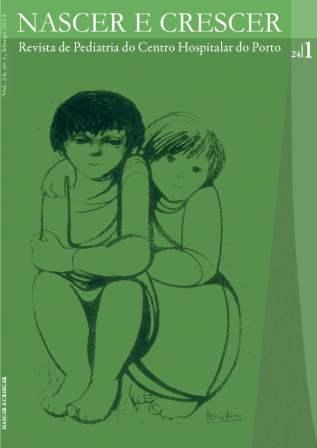Preterm infants under 27 weeks gestational age: outcomes in a tertiary hospital
DOI:
https://doi.org/10.25753/BirthGrowthMJ.v24.i1.8572Keywords:
Extremely preterm, outcomes, models, parental counselingAbstract
Introduction: Over the last decades, survival of extremely preterm infants improved but there´s still significant morbidity among this group. We pretend to evaluate if specific attitudes/characteristics are associated with higher survival or survival without severe disabilities and elaborate predicting outcome models.
Material and Methods: Observational descriptive study, including the 205 liveborn/stillborn infants -gestational age 22w0d-26w6d- born at an Obstetrics Unit or transferred to a Neonatology Unit of a Level III Hospital, from January-2000 to December-2009. We collected variables related to management in the prenatal/neonatal period, neonate performances and psychomotor development(18-24 months). Significant associations between variables/outcomes were identified by chi-square test or t-test; multivariate logistic regression models were used to describe and predict mortality/morbidity.
Results: Advanced Gestational Age (GA) (p=0.001), antenatal corticotherapy(p=0.001), cesarean section(p=0.001), inborn delivery(p=0.021) and increased weight(p=0.001) were associated with survival. Absence of Intraventricular Hemorrhage (IVH) grade 3-4(p=0.001) and absence of Periventricular Leukomalacia (PVL) (p=0.005) were associated with survival without severe neurossensorial deficit. According to multivariable models, advanced GA (OR=0.353,CI95% 0.208-0.599), increased weight (OR=0.996,CI95% 0.993-0.999) and antenatal corticotherapy (OR=0.150,CI95% 0.044-0.510) were associated with lower mortality risk. Rupture of membranes less than 12 h duration was associated with higher mortality risk (OR=3.88,CI95% 1.406-10.680). IVH grades 3-4 was associated with higher morbidity risk (OR=16.931,CI95% 2.744-104.452). Mortality and severe morbidity models predicted correctly the outcome in 78.1% and 85.7% of the cases, respectively.
Conclusions: Mortality/morbidity models might be valuable tools providing insight in the prediction of the outcome of these neonates and helping parental counseling.
Downloads
References
Seri I, Evans J. Limits of viability: definition of the gray zone. Journal of Perinatology 2008;28:S4-8.
The EXPRESS Group. One-Year Survival of Extremely Preterm Infants After Active Perinatal Care in Sweden. Journal of American Medical Association 2009;301(21):2225-33.
Kaiser J, Tilford JM, Simpson PM, Salhab WA, Rosenfeld CR. Hospital Survival of Very-Low-Birth-Weight Neonates from 1977 to 2000. Journal of Perinatology 2004;24:343-50.
Wang Y, Tanbo T, Ellingsen L, Abyholm T, Henriksen T. Effect of pregestational maternal, obstetric and perinatal factors on neonatal outcome in extreme prematurity. Arch Gynecol Obstet 2011;404-011:1870-5.
Bodeau-Livinec F, Marlow N, Ancel PY, Kurinczuk JJ, Costeloe K, Kaminski M. Impact of Intensive Care Practices on Short-Term and Long-term Outcomes for Extremely Preterm Infants: Comparison Between the British Isles and France. Pediatrics 2008;122:e1014-21.
Lorenz JM, Wooliever DE, Jetton JR, Paneth N. A Quantitative Review of Mortality and Developmental Disability in Extremely Premature Newborns. Arch Pediatr Adolesc Med 1998;152:425-35.
Vento M, Cheung PY, Aguar M. The First Golden Minutes of the Extremely-Low-Gestational-Age Neonate: A Gentle Approach. Neonatology 2009;95:286-98.
Berger T, Bervet V, Alama SE, Fauchère JC, Hosli I, Irion O, et al. Perinatal care at the limit of viability between 22 and 26 completed weeks of gestation in Switzerland. The European Journal of Medical Sciences 2011;141:w13280.
Blanco F, Suresh G, Howard D, Soll RF. Ensuring Accurate Knowledge of Prematurity Outcomes for Prenatal Counseling. Pediatrics 2005;115:e478-87.
Marlow N, Wolke D, Bracewell MA, Samara M. Neurologic and Developmental Disability at Six Years of Age after Extremely Preterm Birth. The New England Journal of Medicine 2005;352,1: 9-18.
Pignotti MS, Donzelli G. Perinatal Care at the Threshold of Viability: An International Comparison of Practical Guidelines for the Treatment of Extremely Preterm Births. Pediatrics. 2008;121,1:e193-8.
Field DJ, Dorling JS, Manktelow BN, Draper ES. Survival of extremely premature babies in a geographically defined population: prospective cohort study of 1994-9 compared with 2000-5. British Medical Journal 2008;online edition:1-4.
Kent AL, Casey A, Lui K. Collaborative decision-making for extreme premature delivery. Journal of Paediatrics and Child Health. 2007;43:489-91.
Kaempf JW, Tomlinson MW, Campbell B, Ferguson L, Stewart VT. Counseling pregnant women who may deliver extremely premature infants: Medical care guidelines, family choices and neonatal outcomes. Pediatrics 2009;123,6:1509-15.
Keogh J, Sinn J, Hollebone K, Bajuk B, Fischer W, Lui K. Delivery in “the grey zone”: Collaborative Approach to extremely preterm birth. Australian and New Zealand Journal of Obstetrics and Gynaecology 2007;47:273-8.
Secção de Neonatologia da Sociedade Portuguesa de Pediatria. Consensos em Neonatologia. 2004.
Guillén U, Suh S, Munson D, Posencheg M, Truitt E, Zupancic JAF, et al. Development and Pretesting of a Decision-Aid to Use When Counseling Parents Facing Imminent Extreme Premature Delivery. The Journal of Pediatrics 2012;160,3:382-7.
Schroeder J. Ethical issues for parents of extremely premature infants. Journal of Paediatrics and Child Health 2008;44:302-4.
Kaempf JW, Tomlinson M, Arduza C, Anderson S, Campbell B, Ferguson LA, et al. Medical Staff Guidelines for Periviability Pregnancy Counseling and Treatment of Extremely Premature Infants. Pediatrics 2006;117,1:22-9.
Savage TA, Kavanaugh K. Resuscitation of Extremely Preterm Infant: a Perspective from the Social Model of Disability. Newborn and Infant Nursing Reviews 2004;4,2:114-20.
Chan KL, Kean LH, Marlow N. Staff views on management of the extremely preterm infant. European Journal of Obstetrics and Gynecology and Reproductive Biology 2006;128:142-7.
Downloads
Published
How to Cite
Issue
Section
License
Copyright and Authors' Rights
All articles published in Nascer e Crescer - Birth and Growth Medical Journal are Open Access and comply with the requirements of funding agencies or academic institutions. For use by third parties, Nascer e Crescer - Birth and Growth Medical Journal adheres to the terms of the Creative Commons License "Attribution - Non-Commercial Use (CC-BY-NC)".
It is the author's responsibility to obtain permission to reproduce figures, tables, etc. from other publications.
Authors must submit a Conflict of Interest statement and an Authorship Form with the submission of the article. An e-mail will be sent to the corresponding author confirming receipt of the manuscript.
Authors are permitted to make their articles available in repositories at their home institutions, provided that they always indicate where the articles were published and adhere to the terms of the Creative Commons license.


